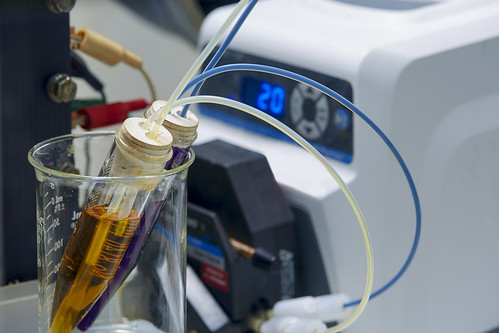
PNNL’s all-organic aqueous flow battery uses two inexpensive and readily available electrolytes, one containing methyl viologen and another with 4-HO-TEMPO.
Organic battery will be 60% cheaper than standard vanadium flow battery. The organic aqueous flow battery is expected to cost $180 per kilowatt-hour once the technology is fully developed. The lower cost is due to the battery’s active materials being inexpensive organic molecules, compared to the commodity metals used in today’s flow batteries.
“Moving from transition metal elements to synthesized molecules is a significant advancement because it links battery costs to manufacturing rather than commodity metals pricing” said Imre Gyuk. “The battery’s water-based liquid electrolytes are also designed to be a drop-in replacement for current flow battery systems,” said PNNL materials scientist Wei Wang. “Current flow battery owners can keep their existing infrastructure, drain their more expensive electrolytes and replace them with PNNL’s electrolytes.”
Flow batteries generate power by pumping liquids from external tanks into a central stack. The tanks contain liquid electrolytes that store energy. When energy is needed, pumps move the electrolytes from both tanks into the stack where electricity is produced by an electrochemical reaction.

PNNL researcher Xiaoliang Wei prepares a small demonstration organic flow battery.
Both flow and solid batteries, eg lithium-ion batteries that power most electric vehicles and smartphones today, were invented in the 1970s. Lithium-ion batteries can carry much more energy in a smaller space, making them ideal for mobile uses. Lithium-ion batteries now make up about 70% of the world’s working, grid-connected batteries, according to data from DOE-OE’s Global Energy Storage Database. However issues with performance, safety and lifespan can limit the technology’s use for stationary energy storage.
Flow batteries, on the other hand, store active chemicals separately until power is needed, greatly reducing safety concerns. Vanadium-based flow batteries have become more popular in recent years, especially after PNNL developed a new vanadium battery design in 2011 that increased storage capacity by 70%. Nearly 79% of the world’s flow batteries are vanadium-based. While vanadium chemistries are expected to be the standard for some time, future flow battery cost reductions will require less expensive alternatives such as organics.
PNNL’s flow battery has 2 main electrolytes: a methyl viologen anolyte (negative electrolyte) and a 4-hydroxy-2,2,6,6-tetramethylpiperidin-1-oxyl, or 4-HO-TEMPO catholyte (positive electrolyte). A 3rd supporting electrolyte carries NaCl, whose Cl- enable the battery to discharge electricity by shuffling electrons in the central stack. “Using readily available materials makes our all-organic aqueous flow battery more sustainable and environmentally friendly. As a result, it can also make the renewable energy it stores and the power grid it supports greener,” Wei said.
Their test battery’s optimal performance was between 40 and 50 milliAmperes per sq cm, where ~70% of the battery’s original voltage was retained. It continued to operate well beyond 100 cycles. Next, the team plans to make a larger version of their test battery that is able to store up to 5 kilowatts of electricity, which could support the peak load of a typical U.S. home. Other ongoing efforts include improving the battery’s cycling so it can retain more of its storage capacity longer. https://www.youtube.com/watch?v=lAW-mMsCNlU http://www.pnnl.gov/news/release.aspx?id=4246







Recent Comments